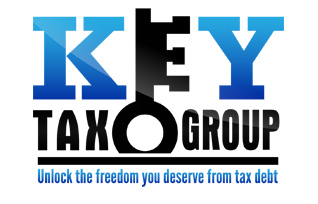When you owe back taxes to the IRS, you are likely experiencing a significant amount of stress, perhaps even feeling physical symptoms such as headaches or stomachaches or finding it difficult to sleep. You probably don’t know how to address the tax situation and may procrastinate because of the low energy that can occur with stress—which, as you know, only makes the situation worse. “I’ll take care of this tomorrow,” just doesn’t work anymore.
Fortunately, there are ways to address this challenge and get your back taxes paid. This article will take you through the ins and outs of paying them through the IRS program known as Fresh Start. Any time that you have questions, you can contact Key Tax Group online or call (800) 380-7085.
Failure-to-File or Failure-to-Pay
Initially, if you don’t file your tax return (or an extension to file), you can be charged a failure-to-file penalty, which is five percent of your unpaid taxes each month. If you file but don’t pay, there is a similar penalty—the failure-to-pay penalty—along with interest charged on what you owe. You can find more information about these penalties from the IRS. (If you find yourself in a situation where you can’t pay your federal taxes right away, you must still file your tax return.)
As time goes by, and you still haven’t filed—or you’ve filed your tax return but haven’t addressed the late payment—the IRS can and will garnish your wages & levy bank accounts to collect the funds and/or file a notice of a federal tax lien, placing the lien upon your property. Ultimately, the IRS could seize your property. Other even more serious consequences include tax evasion charges and the revocation of your passport.
Wherever you find yourself in the timeline described above, it’s important to address the back-tax situation as soon as possible. Often, people can find significant relief through the IRS’s debt forgiveness options.
IRS Debt Forgiveness Program
 First, let’s take a high-level look at the most extreme situation: You’re in a financial bind, one where you can’t possibly pay back all the back taxes you owe. In those instances, the IRS has a debt forgiveness program that, at its core, means the IRS can’t collect back taxes if it would force someone into a financial crisis. So, if you qualify, you could have part of your tax debt “forgiven,” which means you would no longer owe the forgiven part of the debt. Your current financial situation is carefully examined to see if you qualify and, if so, to what degree.
First, let’s take a high-level look at the most extreme situation: You’re in a financial bind, one where you can’t possibly pay back all the back taxes you owe. In those instances, the IRS has a debt forgiveness program that, at its core, means the IRS can’t collect back taxes if it would force someone into a financial crisis. So, if you qualify, you could have part of your tax debt “forgiven,” which means you would no longer owe the forgiven part of the debt. Your current financial situation is carefully examined to see if you qualify and, if so, to what degree.
The IRS could decide, for example, to apply a penalty abatement, meaning that it would not charge certain penalties that had accumulated. If all your penalties were forgiven, this would allow you to pay what you originally would have owed had you not failed to file and/or pay your tax debt. More commonly, penalty abatements reduce the dollar amount of penalties charged.
The IRS has a specific program within its debt forgiveness package called Fresh Start, with its intent being to help taxpayers (individuals and small business taxpayers) to pay back taxes and avoid having tax liens placed on their properties.
Currently, this program can provide relief in three different, broad ways. They are through the:
- Tax Lien Features
- Installment Agreement Features
- Offers in Compromise Features
The Fresh Start program was started in 2008 with the creation of policies to help reduce the number of tax liens being imposed. This helped people with financial problems refinance or sell their homes, which would often help to bring financial relief to them.
Since then, Fresh Start has continued to evolve. In 2011, additional changes were made with tax lien policies, with small businesses benefiting from expanded thresholds with the installment agreement portion of the program. In March 2012, additional steps were taken to streamline the installment agreement process, and relief was provided to people who were unemployed for 30 days or more. Relief was also provided to self-employed people who had experienced a reduction in their income of at least 25 percent.
Here are more details about each of the three components of Fresh Start.
IRS Fresh Start Program
Explanation of Tax Liens
The IRS can place a tax lien against your property if you fail to pay tax debts owed. The purpose of the lien, from the government’s perspective, is to protect its interest in your property—which can include real estate, financial assets, vehicles, and other personal property—until the tax debt is addressed to the satisfaction of the IRS. The lien is also attached to future assets that you haven’t yet obtained, and will remain that way until the lien is removed. If you are a small business taxpayer, the lien will become attached to all business property, which includes your accounts receivable.
Before a tax lien is filed, the IRS will assess your liability and send a Notice and Demand for Payment, detailing how much you owe. If you don’t fully pay the debt in time, the IRS has the option to begin placing liens. Once this lien is filed on your property, it typically becomes difficult for you to obtain credit and, even if you file for bankruptcy, this lien may continue to be in effect. You can find more information about tax liens from the IRS.
Tax Liens: How Fresh Start Can Help
The Fresh Start program provides a way for taxpayers who owe less than a certain dollar amount to avoid having a tax lien placed on their property. This amount has been increased so that the IRS will generally not file a Notice of Federal Tax Lien on amounts less than $10,000 (although there are exceptions). If a Notice of Federal Tax Lien has already been filed, the IRS may withdraw the lien when the taxpayer meets certain requirements and pays off back debt. To get the lien withdrawn, the taxpayer must request this in writing. The form to use is number 12277: Application for Withdrawal.
If a taxpayer is reducing debt through a direct debit agreement (more about that soon!), it’s possible to qualify for the lien notice withdrawal; once again, a request must be made in writing using Form 12277.
Installment Agreements
Through the Fresh Start program, taxpayers owing back taxes can apply to use a payment plan and can now benefit from streamlined installment agreements. If you owe $50,000 or less, agreements can be set up to allow payments to be made over a six-year (72-month) period. You can apply for this payment plan by using the Online Payment Agreement tool. You may need to provide financial information to the IRS, although a full financial statement is not typically required.
If you owe more than $50,000 or will need more than six years to pay back your debt, you will need to provide the IRS with a financial statement. You may be requested to fill out Collection Information Statement, Form 433-A or Form 433-F. If you would rather not apply online to create a payment plan, you can file Form 9465: Installment Agreement by US mail.
For many taxpayers who owe back taxes, the installment plan is an excellent way to resolve the issue. You need to be careful when signing the Direct Debit Installment Agreement, though: If you default on this agreement, the IRS can file a new Notice of Federal Tax Lien, if applicable, and begin collection actions again. So if there is any chance that you will need to miss payments, it is crucial to discuss the new financial challenges with the IRS.
Offers in Compromise (OIC)
This component of the Fresh Start program allows some taxpayers to settle their debts for less than what is owed. This program has been expanded since it began, allowing greater flexibility when determining how much of the back-tax-related debt and associated penalties must be paid. Note: Effective March 27, 2017, the IRS will not review any new OIC applications for people who have not filed all tax returns required to date. The only exception is for the current year’s tax returns if you’ve filed a valid extension. Also, you can’t use this program is you are currently involved in a bankruptcy proceeding.
With an OIC, you will submit an amount that you believe you can pay. As part of this process, the IRS will look at your income, assets, and expenses, among other factors, to determine if you have the ability to pay your debt in full or to pay more than what you are requesting to pay. If the IRS believes that what you’re offering to pay back is the largest amount that’s reasonable within a certain time frame, the agency will generally accept that offer. If, however, the IRS believes that you can pay the full amount, either all at once or through a payment plan, or more than what you’ve submitted, then the offer will not be accepted. For more information and to see if you might qualify for the OIC program, see the Offer in Compromise Pre-Qualifier tool.
If you’ve decided to request to pay a reduced amount through this program, you can find instructions on submitting the offer plus all relevant forms in the Form 656-B booklet. In most cases, there is a non-refundable application fee of $186. You will also need to make a non-refundable initial payment. This initial payment can be provided in a lump sum, equaling 20 percent of what you’re offering to pay back. If your offer is accepted, you will be notified in writing. You then need to pay back the remaining balance in five payments or less. Or, you can continue to make payments while the IRS is considering your offer. If your offer is then accepted, you continue to make payments until it is paid back.
If you qualify under the low-income certification guidelines, the application fee and the initial payment will be waived. You can find more details about those guidelines in the booklet.
When analyzing your financial situation, the IRS now only looks at one year of your expected future income if you are offering to pay your debt in five months or less. In the past, they considered four years’ worth of income when determining your eligibility for the Fresh Start initiative. If you are offering to pay back debt in a period between six months and 24 months, only two years’ worth of projected future income is considered, down from five years.
When calculating what you could reasonably pay on back debt, the IRS determines an allowable living expense amount; this is money that it will not assume can go towards paying your back tax debt. This amount has been expanded, providing more relief for taxpayers during the payback period. You can now, for example, include credit card payments in your allowable living expense amount, minimum payments on student loans for post-high school education if the loans are guaranteed by the federal government, bank fees and charges, and more.
During the time the offer is being considered by the IRS, it is possible that a Notice of Federal Tax Lien will be filed, but collection efforts will be placed on hold and the collection period is extended appropriately. If your offer is rejected, you have 30 days to appeal by using Form 13711, the Request for Appeal of Offer in Compromise form. The IRS also provides more information about appealing.
Tax Relief Services from Key Tax Group
 We know that this entire process can be extremely stressful, especially when the IRS aggressively pursues wage garnishments, bank levies, and tax liens, and especially when you don’t know how to navigate this complicated process. Fortunately, our team of tax lawyers and enrolled agents, along with an experienced and professional support staff, has helped clients from around the country solve their tax debt problems, even when complicated tax issues and regulations are involved.
We know that this entire process can be extremely stressful, especially when the IRS aggressively pursues wage garnishments, bank levies, and tax liens, and especially when you don’t know how to navigate this complicated process. Fortunately, our team of tax lawyers and enrolled agents, along with an experienced and professional support staff, has helped clients from around the country solve their tax debt problems, even when complicated tax issues and regulations are involved.
Here’s something else to think about. Sometimes, the IRS requires certain conditions for Fresh Start participation that might not be ideal for your situation. For example, you might have to agree to extend the statute of limitations (currently 10 years) on tax collections, or you might be required to provide financial information that isn’t in your best interests to provide. So it makes sense to consult with tax experts before you make a move that might not be the right one for you.
We offer no-obligation consultations that are absolutely free, and are experts at creating tax relief solutions that are uniquely tailored to your situation. We also offer affordable payments so you can get the relief you deserve. It’s time to take your life back, and we’re here to help. Let’s get you started on your road to freedom today. Contact Key Tax Group online or call (800) 380-7085.
